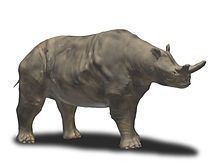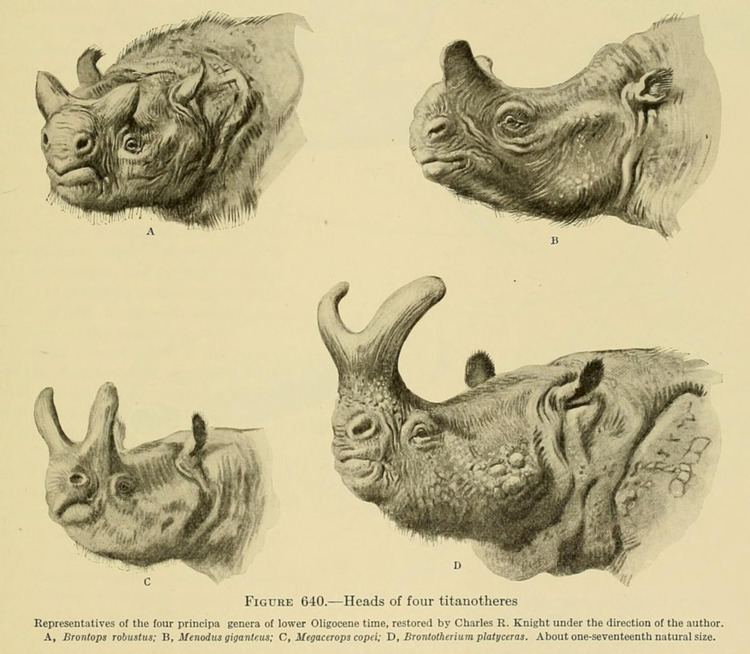Kingdom Animalia Scientific name Brontotheriidae Higher classification Odd-toed ungulate Order Odd-toed ungulate | Suborder Hippomorpha Phylum Chordata Rank Family | |
 | ||
Lower classifications Brontotherium, Megacerops | ||
Brontotheriidae, also called Titanotheriidae, is a family of extinct mammals belonging to the order Perissodactyla, the order that includes horses, rhinoceroses, and tapirs. Superficially they looked rather like rhinos, although they were actually more closely related to horses, with both Equidae and Brontotheriidae making up the suborder Hippomorpha. They lived around 56–34 million years ago, until the very close of the Eocene.
Contents

Characteristics and evolution

Brontotheres retain four toes on their front feet and three toes on their hind feet. Their teeth are adapted to shearing (cutting) relatively nonabrasive vegetation. Their molars have a characteristic W-shaped ectoloph (outer shearing blade).
The evolutionary history of this group is well known, due to an excellent fossil record in North America. The earliest brontotheres, such as Eotitanops, were rather small, no more than a meter in height, and were hornless.
Brontotheres, over time, evolved massive body sizes, although some small species, such as Nanotitanops did persist through the Eocene. Some genera, such as Dolichorhinus, evolved highly elongated skulls. Later brontotheres were massive in size, up to 2.5 m (8.2 ft) in height with bizarre horn-like skull appendages. For instance the North American brontothere Megacerops evolved large sexually dimorphic paired horns above their noses. The sexually dimorphic horns suggest that brontotheres were highly gregarious (social) and males may have performed some sort of head clashing behavior in competition for mates. However, unlike rhinos, the horns of brontotheres are composed of bone, the frontal bone and nasal bone, and were placed side-to-side rather than front-to-back.
Brontotheres probably became extinct due to an inability to adapt to drier conditions and tougher vegetation (such as grasses) that spread during the Oligocene.
Classification of Brontotheres
Two classification systems for the Brontotheriidae are presented below. The first contains 43 genera and 8 subfamilies, and although it is based on a 1997 publication by McKenna and Bell, it summarizes research that was conducted before 1920 and is badly outdated. The second classification is based on 2004 and 2005 research by Mihlbachler et al., which indicates that many of the previous subfamily names are invalid. Several more recently discovered brontotheres are included in the newer classification.
Although Lambdotherium and Xenicohippus were previously included in the Brontotheriidae, they are no longer considered members of this family. Lambdotherium, though excluded, may be the closest known relative to brontotheres. Xenicohippus is now thought to be an early member of the horse family, Equidae.
